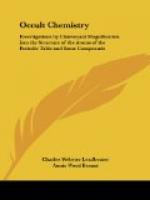In the dissociation of these, each group breaks up into two, the two linear triplets joining each other and setting free their triangular comrade, while two of the triangular triplets similarly remain together, casting out the third, so that hydrogen yields four meta-compounds.
In the hyper-condition, the connexion between the double triplets is broken, and they become four independent groups, two like ix, in the hyper-types (p. 25), and two remaining linear, but rearranging their internal relations; the two remaining groups break up into two pairs and a unit.
The final dissociation sets all the atoms free.
OCCULTUM (Plate VI, 1).
[Illustration]
On the first dissociation of the component parts of occultum, the tetrahedron separates as a whole, with its four “cigars,” flattening itself out within its hole, a; two “cigars” are positive and two negative, marked respectively a and a’. The rope becomes a ring within a sphere, b, and the two bodies d d, which are loose in the gaseous atom, come within this ring. The balloon becomes a sphere.
On further dissociation, the “cigars” go off independently, showing two types, and these again each divide into triplets, as meta-compounds. B, on the meta-level, casts out the two d bodies, which become independent triplets, and the “rope” breaks into two, a close ring of seven atoms and a double cross of eight. These subdivide again to form hyper-compounds, the ring yielding a quintet and a pair, and the double cross separating into its two parts.
The balloon, c, becomes much divided, the cohesion of its parts being slight; it forms two triplets, a pair and a unit, and these set free, on further dissociation, no less than five separate atoms and two duads.
The two triplets of d each cast out an atom on dissociation, and form two pairs and two units.
SODIUM (Plate VI, 2).
It is convenient to consider sodium next, because it is the basic pattern on which not only copper, silver and gold are formed, but also chlorine, bromine and iodine.
[Illustration]
When sodium is set free from its gaseous condition, it divides up into thirty-one bodies—twenty-four separate funnels, four bodies derived from the two central globes, and three from the connecting rod. The funnels become spheres, and each contains four enclosed spheres, with more or less complicated contents. Each central globe yields a sextet and a quartet, and the rod sets free two quartets and a peculiarly formed sextet.




